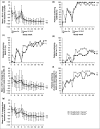Dupilumab in adolescents with uncontrolled moderate-to-severe atopic dermatitis: results from a phase IIa open-label trial and subsequent phase III open-label extension
- PMID: 31595499
- PMCID: PMC6972638
- DOI: 10.1111/bjd.18476
Dupilumab in adolescents with uncontrolled moderate-to-severe atopic dermatitis: results from a phase IIa open-label trial and subsequent phase III open-label extension
Abstract
Background: Dupilumab (monoclonal antibody inhibiting IL-4/IL-13 signalling) is approved for use in adolescents aged ≥ 12 years with inadequately controlled moderate-to-severe atopic dermatitis (AD). Dupilumab significantly improved AD signs/symptoms in a 16-week, randomised, placebo-controlled phase III trial in adolescents (NCT03054428).
Objectives: To characterize the pharmacokinetics of dupilumab, and long-term safety and efficacy in adolescents.
Methods: This was a global, multicentre, phase IIa, open-label, ascending-dose, sequential cohort study with a phase III open-label extension (OLE) in adolescents with moderate-to-severe AD. In the phase IIa study, patients received one dupilumab dose (2 mg kg-1 or 4 mg kg-1 ) and 8 weeks of pharmacokinetic sampling. Thereafter, patients received the same dose weekly for 4 weeks, with 8-week safety follow-up. Patients then enrolled in the OLE, continuing 2 mg kg-1 or 4 mg kg-1 dupilumab weekly. Primary end points were dupilumab concentration-time profile and incidence of treatment-emergent adverse events (TEAEs). Secondary outcomes included Eczema Area and Severity Index (EASI).
Results: Forty adolescents received dupilumab in the phase IIa study; 36 enrolled in the OLE. Dupilumab showed nonlinear, target-mediated pharmacokinetics. Mean ± SD trough dupilumab concentrations in serum at week 48 (OLE) were 74 ± 19 mg L-1 and 161 ± 60 mg L-1 for 2 mg kg-1 and 4 mg kg-1 , respectively. Dupilumab was well tolerated over 52 weeks; the most common TEAEs were nasopharyngitis (week 52: 41% [2 mg kg-1 ], 47% [4 mg kg-1 ]) and AD exacerbation (29%, 42%). After one dupilumab dose in the phase IIa study, EASI improved from baseline to week 2 [mean ± SD reduction -34% ± 20% (2 mg kg-1 ) and -51% ± 29% (4 mg kg-1 )]. With continuing treatment, EASI scores improved further [week 52: -85% ± 12% (2 mg kg-1 ) and -84% ± 20% (4 mg kg-1 )].
Conclusions: In adolescents with moderate-to-severe AD, dupilumab's pharmacokinetic profile was similar to that in adults. These 52-week safety and efficacy data support long-term use of dupilumab in this patient population. What's already known about this topic? Adolescents with moderate-to-severe atopic dermatitis (AD) have high unmet medical need, with significant disease burden and limited treatment options. Dupilumab (monoclonal antibody against interleukin-4 receptor α) is approved for the treatment of adolescents with moderate-to-severe AD who are inadequately responsive to standard of care (U.S.A.) or candidates for systemic therapy (European Union). A 16-week, randomized, placebo-controlled phase III trial in adolescents demonstrated significant improvements in AD signs/symptoms with an acceptable safety profile. What does this study add? These studies demonstrate the long-term safety and efficacy of dupilumab in adolescents with moderate-to-severe AD for up to 52 weeks of treatment, thus extending and reinforcing the findings from the 16-week dupilumab phase III trial. The data from these studies also support the use of dupilumab in combination with current standard of care (topical corticosteroids), which was not evaluated in the 16-week phase III monotherapy trial.
Trial registration: ClinicalTrials.gov NCT03054428 NCT02407756.
© 2019 The Authors. British Journal of Dermatology published by John Wiley & Sons Ltd on behalf of British Association of Dermatologists.
Figures


References
-
- Odhiambo JA, Williams HC, Clayton TO et al; ISAAC Phase Three Study Group . Global variations in prevalence of eczema symptoms in children from ISAAC Phase Three. J Allergy Clin Immunol 2009; 124:1251–58.e23. - PubMed
-
- Halvorsen JA, Lien L, Dalgard F et al Suicidal ideation, mental health problems, and social function in adolescents with eczema: a population‐based study. J Invest Dermatol 2014; 134:1847–54. - PubMed

